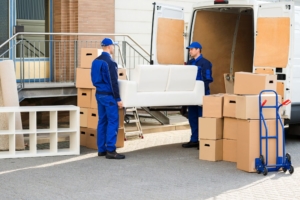
From packing your belongings to finding the right moving company, changing homes can be a difficult undertaking. However, with the right planning and preparation, moving can be a low-stress experience. To help make your move easier, we put together a guide full of tips and tasks to remember before the big day. Read on to learn about common moving questions and what you need to do before, during, and after your move.
Creating a timeline, budgeting, and hiring professional services are all things you should do prior to your move. Here’s a comprehensive list of items and tasks to consider before your move-in day.
Understanding the Moving Timeline
Allow for about six months of planning prior to your moving date. The first agenda item to consider is your budget. Moving expenses can add up fast, so it’s important to calculate a rough estimate of what your move might cost. Items such as moving boxes, packing peanuts, and insurance should be considered in addition to services like professional movers.
- A couple of months before your move, remove any unused items you don’t want at your new home. While some things may need to be discarded, others like used clothing, furniture, and small appliances can be donated or sold. You should also organize medical documents, banking statements, and educational records if you have school-aged children during the decluttering process. Your files will be easier to move when they’re in a single location.
- A month before your move: At this time, you’ll want to start packing, give notice to your landlord (if you’re renting), change your address with the An Post, and search for a professional moving company.
- A couple of weeks before your move: Notify your child’s school of the change in address and request time off from work. You should ask for about two days off, though you may need to request an additional day or two if you’re moving more than a few bedrooms.
Hiring Movers or Moving Services
Hiring a professional moving service can alleviate a primary source of your stress on moving day. Many of the top moving companies offer various services, including loading and unloading, transportation and delivery, furniture assembly, and vehicle relocation. We recommend getting a moving quote from at least three different companies to compare pricing, services, and promotions.
While comparing moving quotes, you should also consider the reputation of each company. Be sure that the company you select is licensed and insured so that your belongings are protected during the move. Additionally, you’ll want to carefully review your selected company’s contract, which will outline the terms and conditions of your move.
Reputable moving companies offer basic, released-value protection at no additional cost. This coverage typically offers protection for 60 cents per pound of a broken or damaged item. If you own high-value items or are looking for added protection, you should consider purchasing additional moving insurance. Most movers offer full-value protection packages, which repair or replace damaged items based on their market value.
One final factor to consider before selecting a professional mover is the distance between your current location and your future home. If you’re moving to a new state or to a location that’s a considerable distance from your current one, you may want to consider an international moving company. These companies offer unique services that help you with your long journey, such as long-term storage, vehicle transportation, and GPS tracking.
If you’re interested in an alternative to a traditional full-service mover, consider a shipping container company. You can book and schedule your move directly with a moving container company of your choice, one of which will drop container(s) at your home upon request. Once your container arrives, you load your belongings and notify the provider, who will ship them to your new home. Selecting a moving container company can be a more affordable and flexible option over traditional moving services, though it requires a bit more effort on your part.
Canceling, Forwarding, and Starting Services
There’s a collection of services, subscriptions, bills, and mail linked to your current address. It’s important to cancel or transfer these items to your new location before the move. Below is a list of services to cancel or adjust before your move:
- Water
- Electricity
- Wireless internet and cable
- Heating and air conditioning
- Gas
- Home security system
- Food subscription boxes
- Pest and landscaping services
Close your utilities about two weeks before moving. While you may need to cancel services at your current home and schedule services at your new location, you may be able to transfer utilities to your new address. You should leave about two days of overlap between the closing of your old utilities and the opening of your new ones.
If you have a home security system, check with your provider to see if you can transfer service. If your provider is unavailable at your new location, read this guide to the best home security companies to find a trusted provider in your new area.
You’ll also need to report address changes to your paycheck providers, banks, and insurance so that important information is mailed to your current residence.
Getting Rid of Items
Inevitably, you’ll need to leave some items behind when you transition to your new home. The less stuff you have, the less space, time, and money it takes to move. That’s why it’s important to know which items you’re taking, donating, or throwing away.
The easiest way to declutter your home is by going room to room searching for items you no longer use. For example, clear out old DVDs, CDs, and books in your living room and get rid of expired food, old sauce packets, and unused cookware in your kitchen. From there, you can decide on the best way to dispose of each item.
You might be able to sell some of your valuable unused items on third-party marketplaces or e-commerce sites, such as eBay or Facebook Marketplace. Some of these items include furniture, books, and gaming systems that are in good condition. For other weathered and heavily used items, such as clothes, electronics, and kitchenware, consider donating to nonprofits like OxFam or Barnados.
Recycling old items is also a disposal option. While plastic, aluminum, and glass can be placed in your home’s recycling bin for collection, there are some recycling programs for items that can’t be picked up curbside. For example, many phone carriers or electronic retailers, such as Best Buy and Staples, recycle phones, laptops, and other electronics. Some will even give you store credit for items in good condition.
Finally, some items are best left at your home for the new owner. These items include curtains, rugs, gaming tables, appliances, and remodeling equipment. Many people who move leave these items because they’re difficult to transport, don’t fit the decor of their new home or have been negotiated into the contract by the buyer.
Prepping for the Move
Buying the right supplies and packing your items correctly is imperative to a seamless move. Here are some tips and tricks for a proper packing experience.
Supplies
Packing can be an overwhelming process if you’re unprepared. Start by looking for free or affordable moving boxes. You can usually ask for spare boxes at your local liquor store at no cost. Other places to find free moving boxes include third-party sellers like Craigslist, which may have users giving away old boxes at no cost. In a survey of 1,000 individuals, one in four respondents said packing supplies was their “highest hidden cost” of moving. While free boxes are ideal, sometimes they’re unavailable. Luckily, most boxes from Argos or Homebase cost between Euro 1.00 and Euro 5.00 per box.
If possible, ensure that all your boxes are the same size. This will help your boxes fit together on a moving truck or dolly. Furthermore, consider any additional moving supplies you may need. Moving blankets newspapers, labels, and bubble wrap are all important packing items for keeping your stuff safe and organized while moving.
Below is a comprehensive list of the packing and moving supplies you may need for your move:
- Cardboard or plastic moving boxes
- Packing tape
- Packing paper
- Plastic wrap
- Bubble wrap
- Plastic baggies
- Labels
- Markers
- Moving blankets
- Cargo straps
Packing
After purchasing packing supplies, the real fun can begin. Start packing about two or three weeks before move-in day, to complete packing a few days before the date. While full-service movers offer whole-home packing, you may want to take over some of the processes yourself to save on costs.
Start the packing process by room, boxing non-essential items like decorations, pictures, artwork, and books. Be sure to label everything so that you and your movers can place items in the right room for unpacking. Other packing tips include placing heavier items in small boxes or at the bottom of mixed-item boxes, taping each box for added security, and packing each box to its capacity.
Other Tips to Consider
When moving with pets, it’s important to consider the list of essentials your pet will need on your big day. Here’s a list of items to consider setting aside for your pet on moving day:
- Medications
- Treats
- Favorite toys
- Poop bags
- Food
- Water and food bowls
- Crate or playpen
Here are a few non-pet-related items you may want to set aside to keep safe or easily access while moving:
- Toolset
- Toilet paper
- Paper towels
- Garbage bags
- Mobile devices
- Important documents and certificates
During the Move
When your moving day finally arrives, here are some checklist items to ensure the day runs smoothly:
- Do a final sweep of your current home. Be sure nothing is left behind in the basement, attic, crawl spaces, and cabinets.
- Leave items the future homeowner needs. These could include garage door openers, door keys, and security codes.
- If you’re moving into an apartment, check the complex’s moving schedule. There may be an allotted period for moving your belongings.
- Reserve an elevator. If you’re moving into a building with multiple floors and need to use an elevator, check with the front desk to see if you can reserve one. This will expedite the moving process by keeping an elevator free for you at all times.
- Ensure you’re available to answer any of your mover’s questions. If you hire a moving company, make yourself available to point the movers in the right direction or answer any questions they may have. This will ensure your move goes as smoothly as possible.
Packing and Unloading
For all movers, the order of items brought into the new home is important. Start with large pieces of furniture, such as your living room set, dining room table, mattresses, and bed frames. Move on to large boxes and smaller items. If you plan to move house plants, pack the small ones in open boxes cushioned with newspaper. Larger plants can be wrapped in plastic and secured to your moving truck with string or tape.
A moving company will know the best way to pack and unload their trucks. The most helpful thing you can do is allow the movers to do their job and stand by for any questions they may have. It’s also standard practice to tip your movers. Consider tipping $4 to $5 per hour or between 5% and 10% of the total cost of moving.
One final tip: Since the stress of your move is bound to work up an appetite, pack small snacks and drinks to curb your appetite until after the move, when you can finally cook a meal or grab some take-out.
Top 5 FAQs About Moving
What is the difference between a binding estimate and a non-binding estimate?
There are two distinct types of moving estimates: non-binding and binding. A non-binding estimate is what the moving company believes the total cost of the move will be, but it isn’t a guarantee and can increase during move-in day. Factors like shipping weight changes and the number of packing materials used can increase or decrease the initial estimate. A binding estimate is a moving company’s price guarantee and will not change after signing a contract.
How long do I have to file a claim if there is loss or damage to my goods?
If you purchase comprehensive full-value insurance with your moving company, you typically have nine months to file a claim, according to the Federal Motor Carrier Safety Administration (FMCSA).
How is my moving estimate calculated?
Estimates are usually calculated per hour for local moves, with rates ranging from $50 to $250 per hour. Long-distance movers charge by the total weight of your items, but other factors like specialty packing, population density, and fragile items can add to the total bill.
What is the minimum amount of hours movers need to work?
Most movers will charge for a minimum of two hours.
What are cancelling and rescheduling policies?
Most moving companies offer full-deposit refunds if a cancellation is made within a certain period, typically 72 hours. Rescheduling can also be made within a similar timeframe but may change in cost based on rescheduling factors.
Copyright: www.thisoldhousereviews.com




